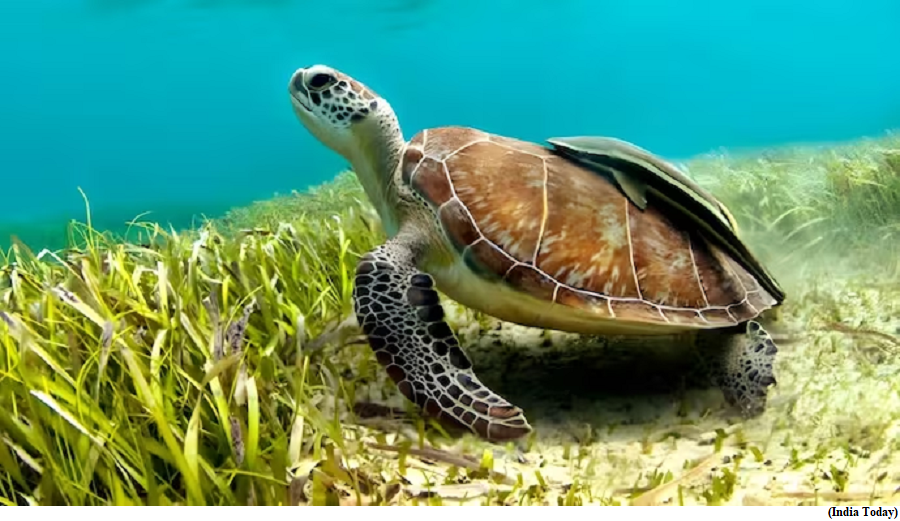India NavIC will now be supported by Made in India chipsets (GS Paper 3, Science and Technology)

Why in news?
- For the first time the chipsets or microchips which are capable of receiving and processing the signals of the indigenous navigational system NavIC will be designed and manufactured in India by an Indian company.
About NavIC:
- NavIC is a satellite based navigational system, developed by Indian Space Research Organization (ISRO), which enables users to determine their precise geographic location and track their movements anywhere in India and 1500 kms beyond India’s territorial boundary.
- It comprises a constellation of seven satellites orbiting high above, weaving a celestial tapestry of signals that empower navigation, positioning and timing across the vast Indian subcontinent and beyond.
- NavIC system primarily uses IRNSS (Indian Regional Navigation Satellite System) signals for navigation and positioning.
- These signals are transmitted by a constellation of satellites in geostationary and geosynchronous orbits. NavIC is like GPS in its functioning and operational principles.
- The only difference being GPS is owned and operated by United States government while NavIC is owned and operated by India. NavIC covers all of Indian subcontinent and offers a positional accuracy of 5 mtrs compared to 15-20 mtrs of GPS.
Role of chipsets:
- Not all smartphones and navigational gadgets (or navigators) are compatible with NavIC. To use and decode NavIC signals, a navigating gadget should have a NavIC compatible chipset or microchip incorporated inside it.
- The receivers of NavIC signals such as NavIC compatible smartphones and other navigators, typically incorporate these chipsets or microchips which are designed to decode and process the signals coming from the seven Indian satellites.
- Currently, they have been using chipsets made by foreign companies such as Qualcomm Technologies of USA and Mediatek Inc. of Taiwan.
Indigenous product:
- Ministry of Science & Technology and Ministry of Electronics & Information Technology, the two ministries of the Government of India, are jointly collaborating with a Hyderabad based firm, - Manjeera Digital Systems Private Limited, to facilitate the designing and commercial production of these chips in India.
- The company has designed baseband processor chip that uses indigenously developed Universal Multifunctional Accelerator (UMA) processor IP, which has ability to receive, read and process the NavIC signals. These chipsets will soon go into large-scale commercial production.
- Manjeera Digital Systems is a fabless semiconductor company with a patented High Performance Computing (HPC) processor called UMA.
- It enables navigation as well as tracking and can be used for both commercial and civilian purposes.
Way Forward:
- NavIC is India's beacon of self-reliance, shining brightly in the world of satellite navigation, and now the indigenously built NavIC enabled chipsets will make it a truly ‘Made in India’ marvel.
India retained the 40th Position in Global Innovation Index 2023
(GS Paper 3, Economy)
Why in news?
- The NITI Aayog, in collaboration with the Confederation of Indian Industry (CII) and the World Intellectual Property Organization (WIPO), Geneva celebrated the unveiling of the Global Innovation Index (GII) 2023 in India.
- India retained the 40th position out of 132 economies, from its 81st rank in 2015.

GII:
- It was released by the World Intellectual Property Organisation (WIPO).
- The index tracks the innovation ecosystem performance of 132 global economies and the most recent global innovation trends.
Global Highlights:
- Switzerland, for a 13th year ranks first in the index. Sweden is now second and the United States on third, followed by the United Kingdom (4th) and Singapore (5th), which enters the top 5.
- China, the sole middle-income economy within the top 30 is now ranked 12th while Japan is 13th.
- The GII listed India as among the 21 economies that outperformed for a 13th consecutive year on innovation relative to level of development. The other countries who achieved the feat included Republic of Moldova and Vietnam.
- The market share of electric vehicle sales across the globe surged from four per cent in 2012 to 14 per cent in 2022.
- The GII report states that India, Iran, Philippines, Turkiye, Vietnam and Indonesia are among the economies within the GII top 65 that climbed fastest in the ranking over the last decade.
- As per CBInsights’ Tracker of Unicorn companies, as of April 2023, there were 1,206 unicorn companies located in 50 different countries globally. Only five economies host 80 per cent of all the world’s unicorns, namely, the United States (54 percent), China (14 percent), India (6 percent), the United Kingdom (4 percent) and Germany (2 percent).
- Out of a total unicorn valuation of USD 3.8 trillion in 2023, US unicorns account of USD 2 trillion – a huge lead – followed by China at USD 736 billion and India at USD 193 billion.
Key Highlights about India from GII 2023:
- India's Consistent Rise: India's continued ascent in the GII, from its 81st rank in 2015 to retaining the current 40th position, underscores the nation's unwavering commitment to innovation. This upward trajectory aligns with the vision of Atma Nirbhar Bharat, championed by the Prime Minister Narendra Modi, emphasizing self-reliance and resilience through innovation.
- Leadership Among Peers: India emerges as the numero uno among 37 lower-middle-income group economies and stands tall as the number one innovation performer among the 10 economies in Central and Southern Asia.
- Consistent Innovation Excellence: India continues to impress by surpassing expectations in relation to its level of development, maintaining its position as an "innovation achiever" for the 13th consecutive year.
- Strengths and Focus Areas: India ranks highest in the Market Sophistication (input pillar) and Knowledge and Technology Outputs (output pillar) categories. It ranks amongst the top 10 in the Infrastructure and Institutions pillars (input pillars).
- Top-Ranked Indicator: India secures the top spot in the "Domestic market scale, bn PPP$" indicator. Furthermore, India is ranked in the top 10 in six additional indicators: "ICT Services exports, % total trade," "Venture capital received, value, % GDP," "Finance for startups and scaleups," "Domestic industry diversification," "Unicorn valuation, % GDP," and "Intangible asset intensity, top 15, %."
- Innovation Outputs: India proudly ranks 35th in innovation outputs, marking an improvement from the previous year.
- Higher Graduates in Science and Engineering: India records 34% of total tertiary graduates in science and engineering in 2021, ranking 11th in this indicator.
- Startup Finance Recognition: India's finance for startups and scaleups earns it the 9th position in this category, while the Venture Capital Performance, though slightly lower than the previous year, secures the 6th position.
- Diverse Domestic Industries: India demonstrates growth in domestic industry diversification, reflecting a 0.46% increase from the prior year, and ranks 10th in this indicator.
- Patents and Citable Documents: India shows a substantial growth in patents by origin, ranking 28th globally. Additionally, it achieved the 20th rank in the citable documents H-index in 2022.
- Unicorn Valuation: India's unicorn valuation stands at 5.04% of GDP in 2023, securing the 9th position in this indicator.
- High-Tech Manufacturing: High-tech manufacturing contributed to 34.23% of the total manufacturing output in 2019, with India ranking 35th in this category.
- Intangible Asset Intensity: India achieved an impressive 8th position in intangible asset intensity, and maintains a Global Brand Value of 210.907 billion USD in 2023, ranking 31st globally.
- Cultural and Creative Exports: India's cultural and creative services exports soared in 2021, up by a substantial 21.4% from the prior year, securing the 18th position in this thriving sector.
Way Forward:
- As India consistently outperforms expectations and excels in various indicators, it stands poised to drive economic growth, foster resilience and embrace self-reliance through innovation.
Two Indian Rhinoceros find sanctuary in Chennai's Arignar Anna Zoological park
(GS Paper 3, Environment)
Why in news?
- A pair of Greater One-Horned Indian Rhinoceros have found a safe haven in the Arignar Anna Zoological Park in Vandaloor.
- It is one of the five existing rhino species worldwide, including the African White Rhino, African Black Rhino, Javan Rhino, and Sumatran Rhino.

Five existing rhino species:
- Belonging to the family Rhinocerotidae, these animals have a rich evolutionary history spanning over 50 million years from the Cenozoic era.
- They share the Order Perissodactyla with horses, zebras, and tapirs, characterized by their unique ability to carry weight on an uneven number of toes, primarily using the middle digit.
- The African White and Black Rhinos, both bearing two horns, lack the lower jaw tusks seen in their Asian counterparts—an adaptation for combating predators like tigers.
- The White Rhino, the largest of the species, stands at a height of up to 2 meters and weighs more than 3.5 tonnes. However, it is functionally extinct with only two females surviving.
- The Black Rhino, measuring 1.7 meters and weighing 1.4 tonnes, boasts the longest horn among the surviving rhino species, measuring up to 130cm.
- The Javan or Lesser One-Horned Rhino, found only in Ujong Kulon, Indonesia, measures 1.6 meters and weighs 1.2 tonnes. With a mere 74 individuals left in the wild, their survival hangs in the balance.
- The Sumatran Rhino, hypothesized to be the oldest rhino species, measures 1.5 meters and weighs 1.05 tonnes. It has two small horns akin to the African species and is critically endangered with around 80 individuals remaining in the wild.
Indian Rhino:
- The Indian Rhino, or Rhinoceros unicornis, is the second-largest rhino species, measuring 2 meters and weighing 3 tonnes.
- The Indian Rhino's population has seen a significant increase from 1500 in the 1980s to over 4000 in 2023 due to extensive conservation efforts.
- The Indian Rhino is an open grassland species living in swampy areas.
- It is facing a lot of threat just like African Rhino species due to poaching for their horns which are nothing but made of Keratin, the same protein found in human hair and nails.
DNA traces found in six-million-year-old fossil of sea turtle
(GS Paper 3, Science and Technology)
Why in news?
- Researchers have found remnants of DNA in the fossilised remains of a sea turtle dating back six million years.
- This marks one of the rare instances where genetic material has been identified in such ancient vertebrate fossils.

Details:
- The fossil, excavated along Panama's Caribbean coast in 2015, contained well-preserved bone cells, known as osteocytes.
- Although the fossil is partial, it includes a relatively complete carapace - the turtle's shell. The turtle would have been about a foot long when alive.
DNA remnants:
- DNA is highly perishable, but under certain conditions, it can be preserved in ancient remains. Previous discoveries include DNA from animals, plants, and microbes dating back about two million years, found in sediment at Greenland's remote northernmost point.
- The only older vertebrate fossils found with similar DNA remnants belonged to two dinosaurs - Tyrannosaurus, which lived about 66 million years ago, and Brachylophosaurus, which lived about 78 million years ago.
- DNA remnants have also been reported in insects dating back tens of millions of years.
Turtle fossil:
- The turtle fossil belongs to the same genus, Lepidochelys, as two of the world's seven living species of sea turtles, the Kemp's ridley, the world's smallest sea turtle, and the olive ridley.
- The fossil represents the oldest-known member of Lepidochelys, shedding light on the poorly understood evolutionary history of this genus.
Way Forward:
- The future studies might enable sequencing of very small pieces of DNA to infer things about their close relatives or involve that information in a broader molecular evolutionary study.





